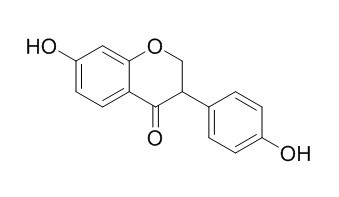Dihydrodaidzein
Dihydrodaidzein-producing bacteria might lead to clarification of some of the mechanisms regulating the production of equol by fecal microbiota.
Inquire / Order:
manager@chemfaces.com
Technical Inquiries:
service@chemfaces.com
Tel:
+86-27-84237783
Fax:
+86-27-84254680
Address:
1 Building, No. 83, CheCheng Rd., Wuhan Economic and Technological Development Zone, Wuhan, Hubei 430056, PRC
Providing storage is as stated on the product vial and the vial is kept tightly sealed, the product can be stored for up to
24 months(2-8C).
Wherever possible, you should prepare and use solutions on the same day. However, if you need to make up stock solutions in advance, we recommend that you store the solution as aliquots in tightly sealed vials at -20C. Generally, these will be useable for up to two weeks. Before use, and prior to opening the vial we recommend that you allow your product to equilibrate to room temperature for at least 1 hour.
Need more advice on solubility, usage and handling? Please email to: service@chemfaces.com
The packaging of the product may have turned upside down during transportation, resulting in the natural compounds adhering to the neck or cap of the vial. take the vial out of its packaging and gently shake to let the compounds fall to the bottom of the vial. for liquid products, centrifuge at 200-500 RPM to gather the liquid at the bottom of the vial. try to avoid loss or contamination during handling.
J Anal Toxicol.2021, bkab015.
VNU J of Science: Med.&Pharm. Sci.2023, 39(1):20-29.
Oncol Rep.2019, 41(4):2453-2463
Analytical Letters 2021, 54(4).
Int J Mol Sci.2023, 24(20):15320.
Auburn University2015, 1-58
J Am Soc Mass Spectrom.2021, 32(5):1205-1214.
Biomolecules.2019, 9(11):E696
Chem Biol Interact.2020, 328:109200.
Life (Basel).2023, 13(2):457.
Related and Featured Products
Biosci Microflora. 2011;30(3):65-71.
Dihydrodaidzein-producing Clostridium-like intestinal bacterium, strain TM-40, affects in vitro metabolism of daidzein by fecal microbiota of human male equol producer and non-producers.[Pubmed:
25045313]
Much attention has been focused on the biological effects of equol, a metabolite of daidzein produced by intestinal microbiota. However, little is known about the role of isoflavone metabolizing bacteria in the intestinal microbiota.
METHODS AND RESULTS:
Recently, we isolated a Dihydrodaidzein (DHD)-producing Clostridium-like bacterium, strain TM-40, from human feces. We investigated the effects of strain TM-40 on in vitro daidzein metabolism by human fecal microbiota from a male equol producer and two male equol non-producers. In the fecal suspension from the male equol non-producer and DHD producer, DHD was detected in the in vitro fecal incubation of daidzein after addition of TM-40. The DHD concentration increased as the concentration of strain TM-40 increased. In the fecal suspension from the equol producer, the fecal equol production was increased by the addition of strain TM-40. The occupation ratios of Bifidobacterium and Lactobacillales were higher in the equol non-producers than in the equol producer. Adding isoflavone-metabolizing bacteria to the fecal microbiota should facilitate the estimation of the metabolism of isoflavonoids by fecal microbiota.
CONCLUSIONS:
Studies on the interactions among equol-producing microbiota and DHD-producing bacteria might lead to clarification of some of the mechanisms regulating the production of equol by fecal microbiota.
Biosci Biotechnol Biochem. 2013;77(11):2210-7.
Transport mechanisms for soy isoflavones and microbial metabolites dihydrogenistein and dihydrodaidzein across monolayers and membranes.[Pubmed:
24200780]
Isoflavone data concerning the metabolism and permeability on intestinal epithelial cells are scarce, particularly for microbial isoflavone metabolites.
METHODS AND RESULTS:
This study evaluates the absorption mechanisms for the isoflavones, genistein and daidzein, and their microbial metabolites, dihydrogenistein (DHG) and Dihydrodaidzein (DHD). The permeability characteristics of isoflavones were compared by using the Caco-2 human colon adenocarcinoma cell line for a parallel artificial membrane permeability assay, and comparing their physicochemical properties.
CONCLUSIONS:
The data suggest that genistein, DHG and DHD were efficiently transported by passive diffusion according to the pH-partition hypothesis. Genistein was conjugated by phase II metabolizing enzymes and acted as a substrate of the breast cancer resistance protein (BCRP). Daidzein was not conjugated but did act as a substrate for BCRP, multidrug resistance-associated proteins, and P-glycoprotein. In contrast, DHG and DHD were markedly more permeable than their parent isoflavones; they were therefore difficult to transport by the efflux effect, and glucuronidation/sulfation was limited by the flux time.
Appl Environ Microbiol. 2005 Jan;71(1):214-9.
Enantioselective synthesis of S-equol from dihydrodaidzein by a newly isolated anaerobic human intestinal bacterium.[Pubmed:
15640190]
A newly isolated rod-shaped, gram-negative anaerobic bacterium from human feces, named Julong 732, was found to be capable of metabolizing the isoflavone Dihydrodaidzein to S-equol under anaerobic conditions.
METHODS AND RESULTS:
The metabolite, equol, was identified by using electron impact ionization mass spectrometry, (1)H and (13)C nuclear magnetic resonance spectroscopy, and UV spectral analyses. However, strain Julong 732 was not able to produce equol from daidzein, and tetrahydrodaidzein and dehydroequol, which are most likely intermediates in the anaerobic metabolism of Dihydrodaidzein, were not detected in bacterial culture medium containing Dihydrodaidzein. Chiral stationary-phase high-performance liquid chromatography eluted only one metabolite, S-equol, which was produced from a bacterial culture containing a racemic mixture of Dihydrodaidzein. Strain Julong 732 did not show racemase activity to transform R-equol to S-equol and vice versa. Its full 16S rRNA gene sequence (1,429 bp) had 92.8% similarity to that of Eggerthella hongkongenis HKU10.
CONCLUSIONS:
This is the first report of a single bacterium capable of converting a racemic mixture of Dihydrodaidzein to enantiomeric pure S-equol.



